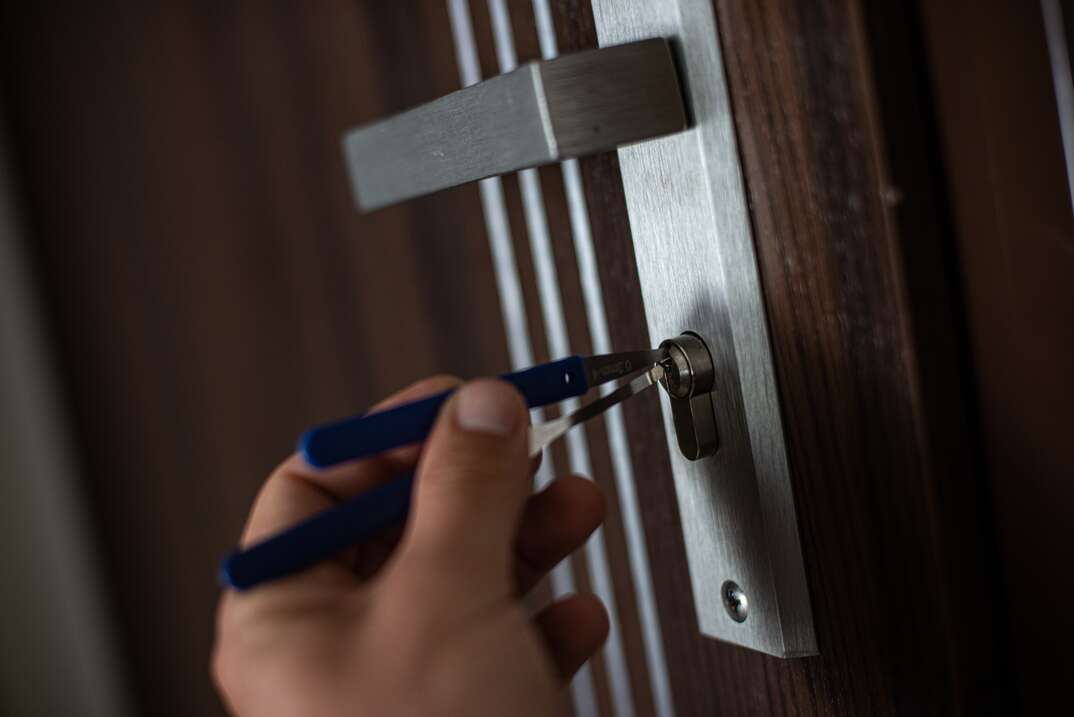- AppliancesElectriciansHVACLandscapingLocksmithPest ControlPlumbingRenovationRoofingT V RepairAll Home Improvement
- Car AccidentClass ActionCorporate LawCriminal DefenseDivorce LawEmployment LawFamily LawFinancial LawLegal AidMedical Injury LawyersMedical MalpracticeReal Estate LawWater Fire RestorationAll Legal
- InvestmentRetirementAll Finance
- Animal InsuranceAutoGeneral InsuranceHealth PolicyHome RentersAll Insurance
- DentalHealth SpecialistsAll Medical
- Animal CareVeterinaryAll Pets
- Auto GlassTowingAll Automotive
3 Signs Your Lock Has Been Tampered With

Have you ever had that unsettling sensation that something in your home is amiss? That the outside door seems not like you left it a few hours ago? You scan your surroundings to ensure you're safe and nothing is missing, but then you notice the scratches on the lock.
Read More Locksmith and Security Articles
Whether it's a door lock, padlock or safe, you may be able to figure out if someone was trying to break in. Here are three signs your lock has been tampered with.
You may not always find evidence that someone attempted to break in or tamper with your locks. However, a thief in a hurry or lacking skill will likely damage locks or leave marks behind. Here are three signs someone was messing with your locks:
1. Scratches or Odd Marks on Your Lock
Traditional lock-picking techniques use various small metal tools to manipulate the lock mechanism. The tools are inserted through the keyhole, and a burglar will attempt to use them instead of a key to open the lock. Some tools may be clamped into the lock while the burglar works with other tools to pick your lock. Because these tools are made of sharp metal pieces, they can leave behind visible signs such as tiny scratch marks.
A technique known as lock bumping is also frequently used to tamper with locks. Lock bumping involves using a special key or tool combined with vibrations to dislodge the pins in a lock. The rough vibrations can cause the tool to scratch or damage the surrounding lock, doorknob or other structure. However, lock bumping tools are sophisticated and don't always leave marks behind.
2. A Damaged Door
Also check the door of your home, safe or other property for damage. Criminals often work hurriedly or may not have a high level of skill. Therefore, they may use a large amount of force to attempt to gain entry, and damage to surrounding doors may be more evident than damage to the lock itself. If attempts at picking a lock don't work, a burglar may apply additional force or use other tools. This method could lead to scratches, splintering or other damage to the door.
3. The Lock No Longer Works Properly
If a thief attempts to break in to steal something, they may not care about conspicuous damage to your locks. You'd likely notice the missing property anyway. But what if you think a snoopy roommate or ex-partner has been getting into your private spaces?
Someone sneaky may be careful not to leave behind scratches or other cosmetic damage, but that doesn't mean they won't damage a lock by tampering. Picking, bumping or forcing a lock may damage the internal mechanisms. If you find a lock is suddenly sticking or your key doesn't seem to work correctly now, it could be a sign of tampering. One sign of lock bumping is a key that doesn't seem to fit in the lock anymore.
More Related Articles:
- 8 Benefits of Installing Smart Locks
- Here’s How Much a Locksmith Charges for 5 of the Most Common Services
- Lose Your Keys Often? Here's How to Prevent Lockouts
- Installing a New Deadbolt? Here's Everything You Need to Know
- What Is Rekeying a Lock?
What Should You Do If You Suspect Your Lock Has Been Tampered With?
If you believe someone is in your home or business without permission or a crime has been committed, you probably know to call the police. However, not every incidence of lock tampering is an emergency. Maybe the police took a report but haven't made an arrest. Or perhaps you only suspect someone has been tinkering with your lock but aren't sure.
If you think someone has been accessing your private space or unsuccessfully attempted to pick a lock, there are things you can do to protect yourself:
- Upgrade your lock. Some locks are easier to pick or break than others. Installing a higher-quality lock can provide additional protection, especially from amateur thieves or nosy roommates. If you believe a lock has been damaged, replacing it is a wise decision.
- Install additional security measures. A deadbolt or alarm adds an extra layer of security and may also serve as a deterrent.
- Consider surveillance options. Security cameras are readily available, and many inexpensive options are on the market. A camera can serve as a deterrent and help you catch the person behind the tampering. Just make sure you comply with any applicable laws, as many jurisdictions have rules about the use of security cameras.
Finally, always prioritize your safety. Contact law enforcement if you're being stalked or believe you're in danger. Tell trusted friends or family members what's happening, and ask for help if you need it.
Elocal Editorial Content is for educational and entertainment purposes only. Editorial Content should not be used as a substitute for advice from a licensed professional in your state reviewing your issue. Systems, equipment, issues and circumstances vary. Follow the manufacturer's safety precautions. The opinions, beliefs and viewpoints expressed by the eLocal Editorial Team and other third-party content providers do not necessarily reflect the opinions, beliefs and viewpoints of eLocal or its affiliate companies. Use of the Blog is subject to the
Website Terms and Conditions.The eLocal Editorial Team operates independently of eLocal USA's marketing and sales decisions.

